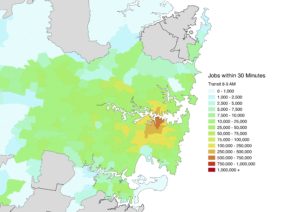
Accessibility measures the ease of reaching destinations and provides a way to evaluate the performance of transport system. The ’30-minutes city’, proposed by Greater Sydney Commission, suggests that that 75% of the people should be able to reach jobs within 30 minutes using transit.
Accessibility has numerous dimensions, considering where, when, what, and how accessibility is measured for whom by what traffic mode based on how much travel cost is taken.
- Where: where accessibility is being measured, a block in downtown, suburban, or exurban area?
- When: when accessibility is being measured, during peak hours or non-peak hours, day time or night time?
- What: what is being accessed, e.g., jobs, schools, shoppings, restaurants, parks, hospitals?
- How: methods to measure accessibility, e.g., primal, dual, place rank, or utility-based accessibility measures.
- For whom: for whom accessibility is being measured, individual persons or a group of individuals aggregated spatially?
- What mode: what mode is being used to access, on foot, by bike, transit, or automobile?
- How much: how much travel cost is being spent to access, measured by travel distance, travel time, or full cost of travel?
Recent accessibility papers by TransportLab
- Allen, Jeff, Farber, Steven, Greaves, Stephen, Clifton, Geoffrey, Wu, Hao, Sarkar, Hao, and Levinson, D. (2021) Immigrant Settlement Patterns, Transit Accessibility, and Transit Use. Journal of Transport Geography. 96 103187 [doi]
- Aoustin, Louise, and Levinson, D. (2021) The Perception of Access in Sydney. Findings, March. [doi]
- Aston, Laura and Levinson, D. (2021) Accessibility-Oriented Planning: Why and How to Make the Switch. ITE Journal (August) 25-29.
- El-Geneidy, Ahmed and Levinson, D. (2021) Making Accessibility Work in Practice Transport Reviews (online first) [doi][first 50 free download]
- Li, Manman, Cui, Mengying, and Levinson, D. (2021) Job and Worker Density and Transit Network Dynamics. International Journal of Sustainable Transportation. [doi]
- Wu, Hao and Levinson, D. (2021) Optimum Stop Spacing for Accessibility. European Journal of Transport and Infrastructure Research. 21(2) 1-18. [doi]
- Wu, Hao, Paolo Avner, Genevieve Boisjoly, Carlos K. V. Braga, Ahmed El-Geneidy, Jie Huang, Tamara Kerzhner, Brendan Murphy, Michał A. Niedzielski, Rafael H. M. Pereira, John P. Pritchard, Anson Stewart, Jiaoe Wang, and David Levinson (2021) Urban access across the globe: an international comparison of different transport modes. NPJ Urban Sustainability 1(16) [doi]
- Wu, Hao, and Levinson, D. (2021) The Ensemble Approach to Forecasting: A Review and Synthesis. Transportation Research part C. Volume 132, 103357 [doi]
- Cui, Mengying and Levinson, D. (2020) Primal and Dual Access. Geographical Analysis. 52, 452–474 [doi] [code]
- Cui, Mengying, and Levinson, D. (2020) Multi-Activity Access: How Activity Choice Affects Opportunity. Transportation Research part D. 85 – 102364 [doi]
- Lahoorpoor, Bahman and Levinson, D. (2020) Catchment if you can: The effect of station entrance and exit locations on accessibility. Journal of Transport Geography. 82, 102556. [doi] [full report]
- Levinson, D. and Wu, Hao (2020) Towards a general theory of access. Journal of Transport and Land Use. 13(1) 129-158. [doi]
- Sarkar, Somwrita, Wu, Hao and Levinson, D. (2020) Measuring polycentricity via network flows, spatial interaction, and percolation. Urban Studies. 57(12), 2402–2422. [doi]
- Wu, Hao and Levinson, D. (2020) Unifying Access. Transportation Research part D. Volume 83, June 2020, 102355 [doi]
- Wu, Hao, Owen, Andrew, and Levinson, D. (2020) Commute Mode Share and Access to Jobs across US Metropolitan Areas. Environment and Planning B. [doi]
- Chaloux, Nick, Boisjoly, Genevieve, Grise, Emily, El-Geneidy, Ahmed, and Levinson, D. (2019) I only get some satisfaction: Introducing satisfaction into measures of accessibility. Transportation Research part F. 62, 833-843. [doi]
- Cui, Boer, Boisjoly, Genevieve, El-Geneidy, Ahmed, and Levinson, D. (2019) Accessibility and the journey to work through the lens of equity. Journal of Transport Geography. 74, 269-277. [doi]
- Cui, Mengying and Levinson, D. (2019) Measuring Full Cost Accessibility by Auto. Journal of Transport and Land Use. 12(1) 649-672. [doi]
- Huang, Jie, Levinson, D., Wang, Jiaoe, Jin, Haitao (2019) Job-worker spatial dynamics in Beijing: Insights from Smart Card Data. Cities 86, 89-93. [doi]
- Wu, Hao, Somwrita Sarkar, and Levinson, D. (2019) How Transit Scaling Shapes Cities. Nature Sustainability doi:10.1038/s41893-019-0427-7 . [doi]
- Cui, Mengying and Levinson, D. (2018) Accessibility Analysis of Risk Severity Transportation. 45(4), 1029–1050. [doi]
- Cui, Mengying and David Levinson (2018) Accessibility and the Ring of Unreliability. Transportmetrica A: Transport Science. 14 (1-2), 4-21. [doi]
- Cui, Mengying and Levinson, D. (2018) Full cost accessibility. Journal of Transport and Land Use. 11(1), 661-679. [doi]
- Deboosere, Robbin, El-Geneidy, Ahmed, and Levinson, D. (2018) Accessibility-Oriented Development. Journal of Transport Geography. 70, 11–20. [doi]
- Huang, Jie, Levinson, D, Wang, Jiaoe, Zhou, Jiangping and Wang, Zi-jia (2018) Tracking job and housing dynamics with smartcard data. PNAS (Proceedings of the National Academy of Sciences) [doi]
- Iacono, Michael and David Levinson (2017) Accessibility Dynamics and Location Premia: Do Land Values Follow Accessibility Changes? Urban Studies. 54(2), 364–381. [doi]
- Jiang, Haibing and David Levinson (2017) Accessibility and the Evaluation of Investments on the Beijing Subway. Journal of Transport and Land Use. 10(1), 395-408. [doi]
- Levinson, David, Bernadette Marion, Andrew Owen, and Mengying Cui (2017) The City is Flatter: Changing Patterns of Job and Labor Access. Cities. 60(B), 124–138.[doi]
- Melo,Patricia, Daniel Graham, David Levinson, and Sarah Aarabi (2017) Agglomeration, Accessibility, and Productivity: Evidence for Large Urbanized Areas in the US. Urban Studies. 54(1), 179–195. [doi]

